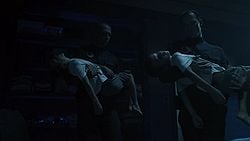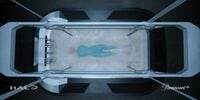Flash cloning
From Halopedia, the Halo wiki
Flash cloning is a human medical process most commonly used to clone body parts.[1] Cells used during cloning must be taken from specific regions within the body. The process can be used to create organs, skin, blood, or other body parts needed by recipients in a short span of time. This allows the creation of blood cells for use in blood transfusions, or the manufacturing of nerve cells to repair certain types of paralysis.[2]
Organ and limb cloning[edit]
The use of donor tissue to grow replacement organs and limbs is a mature technology and has been utilized for centuries.[3]
The process uses a sample of a human's DNA to grow a cloned organ, which can then be transplanted into the subject who contributed the DNA sample. Usually, the organ is programmed to grow at an accelerated rate and cease rapid development when transplanted into the subject. This makes the method viable in urgent situations, where patients cannot afford to spend years waiting for a normal organ to develop. Since the transplanted organ's DNA matches that of the recipient, the risk of transplant rejection is completely eliminated.[1][2]
Flash cloning has replaced donated organs as the standard means of organ replacement for both civilian and military purposes. Organs such as the heart, liver, or the endocrine system can be replaced with cloned parts, which can be used to negate the effects of an unhealthy lifestyle and to extend the lifespan of a human being by decades, as demonstrated by Admiral Preston Cole.[4] There is a risk of genetic damage and growth errors with flash cloning.[3]
Certain lost or damaged body parts, such as eardrums, can be grown in situ on the patient's body. This process is noted as being particularly tedious and requires two weeks of mandatory downtime for military personnel.[5] Dedicated cloning facilities allow the growth of the replacement organ within hours after retrieving the patient's DNA. During the Fall of Reach, Doctor Catherine Halsey used the flash clone facility at CASTLE Base to replace Kelly-087's liver and right lung.[1] Portable flash cloning tanks can be as small as a shoebox and when used by a medical professional in conjunction with a sterile field generator, can be used to perform organ transplantation surgery in the field.[6]
Human cloning[edit]

While flash cloning entire humans is possible, the procedure is by no means perfect; it is illegal in accordance with the UN Colonial Mortal Dictata. The process involves the modification of a cloned human embryo, which causes it to develop one hundred times faster than it would have naturally. Many anomalies appear as a result of this abnormal development rate—they lack the muscle memory and socialization of their hosts. Though these problems can be remedied with intensive therapy, compounding biological defects cannot be corrected. Rapid flash cloning of such immense volumes of tissue induces gross DNA base-pair errors; congenital defects increase 42 percent and incidents of Parkinson's-plus syndromes increase 67 percent. Although a small percentage of flash clones can have a normal life expectancy, most flash clones will start to degenerate from metabolic instability as part of a process called "metabolic cascade failure"—death from various neurological and physiological disorders. The average half-life of a flash clone is 14.7 weeks in laboratory conditions.[7]
Dr. Catherine Halsey developed and perfected a technique through which a living person's memories can be transferred to a flash clone's brain, thus creating a clone that is virtually identical to the original host. This process used a "Fast Fourier Transform X-ray 3-D scan" to map a brain's ionic density patterns. This data could then be used to create a virtual map of every individual link in a brain's neuron pattern. This data would then be used in a deep-stimulating scan of a flash clone's "blank" brain, which would cultivate an identical pattern of linkages and accurately replicate the memories of the host person.[7] Unfortunately, this memory replication results in an 82 percent rate of dementia, schizophrenia, and cancers in the recipient's brain.[7]
This technique was used to create identical clones of the SPARTAN-II candidates, which replaced the children after the candidates were abducted from their homes. Most of the flash clones quickly died of natural deaths, which were explained as preexisting genetic disorders,[8] drawing suspicion away from the Office of Naval Intelligence. Contrary to Halsey's expectations, many of the clones lived far longer than previously estimated based on laboratory conditions,[7] with at least four surviving until 2525.[9] Halsey's attempt to cover up the SPARTAN-II program's use of flash clones (combined with her allegedly selfish motives for using the clones) contributed to her detainment by ONI after the Human-Covenant War.[10]
Usage for creating AI[edit]
Because humanity is a Tier 3 civilization and requires a human brain's neural map for the creation of a "smart" AI, the brain of a deceased person is used. There is one known exception however: Cortana was modeled after a flash clone of Dr. Catherine Halsey's brain. Halsey used the same mothballed equipment used to clone the Spartan candidates to create twenty clones of herself. However, she enhanced the neural physiology at the expense of the rest of their bodies, leaving them seriously malformed.[7] Only one clone brain (designated "H-1") survived, which was then used to create Cortana. Three specimens were placed in cryogenic suspension until a future time when technological advancements made Halsey's plans for them possible. The use of a clone and memory transfer allowed Halsey to provide a brain used for the mapping of the AI's "mind" with no undue effects on the donor.[11] Despite this advantage, the cloning of a human being, particularly for this purpose, is highly illegal and unethical.[7] Cortana showed a belief that repeating this process could be used to recompile her neural network and end her rampancy, but this was never tested.[12] Halsey later sends Blue Team to recover her three surviving cloned brains from a secret cryovault in CASTLE Base which she then uses to create the Weapon in order to stop Cortana.[13][14][15]
Non-canon and dubious canon appearances[edit]
Silver Timeline[edit]
- Main article: Silver Timeline
Flash clones were used by Catherine Halsey to replace the kidnapped children of the SPARTAN-II program.[16] Around the same time, Halsey flash cloned herself, keeping the clone in stasis for years. At the time, Halsey was unsure if human flash cloning would ever be made legal and wondered if she was ever sitting opposite a living, breathing version of herself if she would be able to go through with sacrificing the clone.[17]
By 2552, Halsey intended to use her flash clone to create Cortana. Spotting the clone, Admiral Margaret Parangosky ordered Halsey to destroy it and any others like it.[18]
After UNSC HIGHCOM agreed to the creation of Cortana, Halsey awakened her clone[19] who possessed Halsey's knowledge up until the point of her creation. The clone had some difficulty separating herself from the original with Halsey having to correct her that Halsey had collected the samples that had led to the creation of the clone and the clone was merely the product of those samples. The clone asked Halsey about the fate of the children and Halsey explained that 35 had survived the original augmentation, causing her clone to realize that more than half died which was a far greater percentage that Halsey had imagined when she had cloned herself. Completing the test that Halsey had set up for her in a matter of moments, the clone deduced that Halsey had awakened her as she needed the clone's brain and Halsey revealed that she had perfected the process for real-time neuroelectrical imaging. The clone was amazed that the Cortana system was viable and guessed that Halsey intended to use Cortana on John after Halsey confirmed that integrating the AI into a Spartan was the next step. Halsey admitted that John had gotten himself into some trouble recently and that this was the only way of getting him out of it. The clone seemed surprised that Halsey wasn't bothered by what she had to do and Halsey dodged her questions about Miranda. The clone reminded Halsey of her doubts about being able to go through with it when Halsey had first done the cloning and wondered what had changed and Halsey simply stated that it was "progress."[17]
Adun Saly prepared the clone, warning her that the procedure would be very painful, but providing her with a paralyzing agent in order to keep the clone still. Halsey and Adun extracted the needed neural substrate from the clone, drilling in through her left eye. The process killed the clone, but succeeded in creating Cortana. Adun subsequently dissolved the clone's body in a tank.[17]
After John-117's memories of his kidnapping were unlocked by the Eridanus II keystone, he recalled being replaced with a flash clone by Halsey's forces.[20] With the committee needing a scapegoat for the recent troubles with the Spartan program, Parangosky later had Halsey questioned by Major Ira Halal about her illegal cloning practices before John interrupted them. Secretly observed by Parangosky, Jacob Keyes and Miranda Keyes, Halsey explained how the Spartans had been replaced by genetically-compromised flash clones to hide the kidnappings of the children. The clones experienced nosebleed and headaches and died a short time later. The clones' deaths were then put down to an undiagnosed seizure disorder by the doctors.[21]
After Halsey suddenly went into unexplained seizures and experiences nosebleeds, Miranda, [22] recalling what Halsey had told John,[21] realized that her mother had replaced herself with another flash clone in order to escape. However, the clone died before she could answer any of Miranda's questions.[22]
Six months later, James Ackerson would send in clones of a young girl named Julia to torment a captive Halsey, but they would all die whenever Halsey would attempt to get answers to her questions.[23] Halsey later revealed to Ackerson that she had recognized Julia as his sister Julia Ackerson who had died after her Spartan augmentations failed. When Ackerson euthanized his dementia-addled father before abandoning Reach, he left a clone of Julia with their father as a way of comforting him in his final moments.[24]
Trivia[edit]
In i love bees, Kamal Zaman mentions that flash cloning an entire human being carries a criminal sentence of memory modification.[25] This is not mentioned in Halo: Mortal Dictata, the only source in which the namesake legislation is discussed in any detail.
Gallery[edit]
Concept art of Daisy-023's flash clone for Halo Legends Homecoming.
Daisy-023 facing her flash clone.
Sketch depicting Dr. Halsey's malformed clones in her journal.
Frederic-104's deteriorating flash clone in Halo: The Fall of Reach - The Animated Series.
A flash clone of Catherine Halsey in Halo: The Television Series.
List of appearances[edit]
- Halo: The Fall of Reach (First appearance)
- Halo: The Flood (Mentioned only)
- Halo: First Strike (Mentioned only)
- i love bees (Mentioned only)
- Halo: Ghosts of Onyx (Mentioned only)
- Halo Legends
- Halo: Reach
- Halo: Fall of Reach
- Halo: Glasslands (Mentioned only)
- Scanned
- Halo: Mortal Dictata
- Halo: New Blood (Mentioned only)
- Hunt the Truth (Mentioned only)
- Halo: The Fall of Reach - The Animated Series
- Halo: The Television Series Season One
- Halo: The Television Series Season Two
Sources[edit]
- ^ a b c Halo: First Strike, page 125
- ^ a b Halo Encyclopedia (2009 edition), page 225 (2011)
- ^ a b Halo Encyclopedia (2022 edition), page 29
- ^ Halo: Evolutions, "The Impossible Life and the Possible Death of Preston J. Cole", pages 485-486
- ^ Halo: Ghosts of Onyx, page 114
- ^ Halo: First Strike, page 140
- ^ a b c d e f Halo: Reach, Dr. Halsey's personal journal
- ^ Halo: Glasslands, page ???
- ^ Halo Legends, Homecoming
- ^ Halo: Glasslands, pages 346-352
- ^ Halo: The Fall of Reach, page 18
- ^ Halo 4, campaign level Requiem
- ^ Halo: Shadows of Reach
- ^ Halo Infinite, UNSC Audio log: Recovered Files #03 - The Mission
- ^ Halo Infinite
- ^ Halo: The Television Series
- ^ a b c Halo: The Television Series, episode Emergence
- ^ Halo: The Television Series, episode Contact
- ^ Halo: The Television Series, episode Unbound
- ^ Halo: The Television Series, episode Reckoning
- ^ a b Halo: The Television Series, episode Solace
- ^ a b Halo: The Television Series, episode Transcendence
- ^ Halo: The Television Series, episode Sword
- ^ Halo: The Television Series
- ^ i love bees





